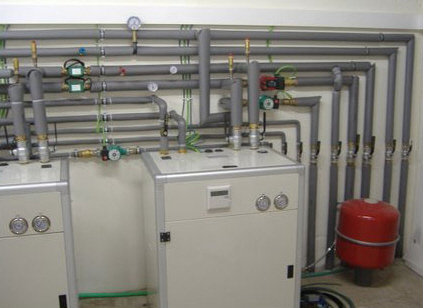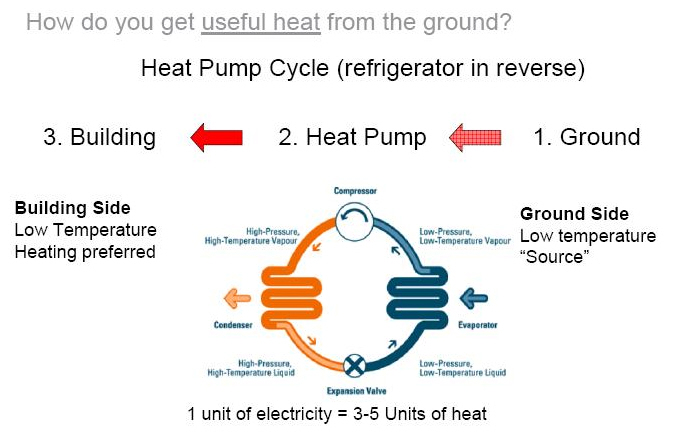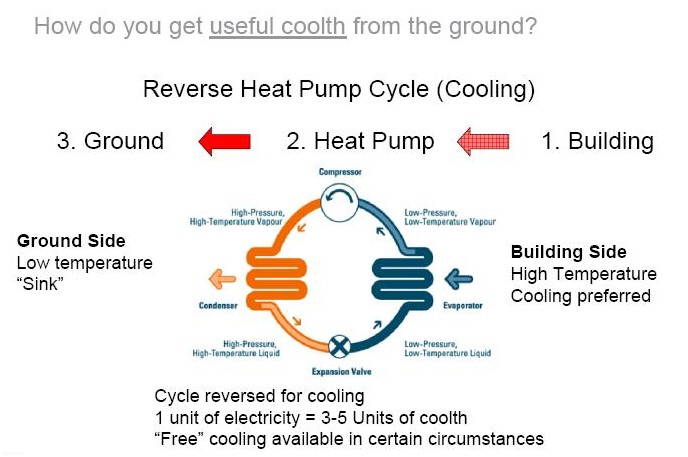Ground source heat pumps
Contents |
[edit] Introduction
Heat is stored by the thermal mass of the ground of water. There are two types of heat sources:
In the UK just a few metres below our feet the ground keeps a constant temperature of about 11-12°C throughout the year.
[edit] Internal heat of the earth
The Earth’s internal heat was originally produced during accretion. Since then heat has been produced by the radioactive decay of elements such as uranium, thorium and potassium. Due to its high enthalpy, this type of heat is often harvested in volcanic areas for electricity production and large district heating.
[edit] Heat from the sun and stored in the ground
The majority of heat stored right in the Earth’s surface comes from the sun. This heat is widely available, and because of its low enthalpy, it is often harvested for local heat pump applications.
There are two types of systems for utilising heat from the sun stored in the ground by a ground source heat pump:
- Open loop
- Closed loop
[edit] Ground source heat pumps
Ground source heat pumps can pump heat from the ground into a building to provide space heating and domestic hot water. For every unit of electricity used to pump the heat, 3-4 units of heat can be produced.
Example of a ground source heat pump system.
[edit] Ground source heat pump system design
There are three important elements to a ground source heat pump system:
- Ground loop. This comprises of lengths of plastic pipe buried in the ground, either in a borehole or a horizontal trench. The pipe is a closed circuit and is filled with a mixture of water and antifreeze, which is pumped round the pipe absorbing heat from the ground.
- Heat pump. Heat pumps are very familiar to us in fridges and air conditioners. A heat pump works by using the evaporation and condensing of a refrigerant to move heat from one place to another. In this case, the evaporator (analogous to the squiggly loop in the cold part of the fridge) takes heat from the water in the ground loop; the condenser (analogous to the hot loop on the back of the fridge) gives up heat to a hot water tank which feeds the distribution system.
- A compressor. This uses electricity, (this is what makes the noise in a fridge) to move the refrigerant around the heat pump. It also compresses the gaseous refrigerant to increase the temperature at which it condenses to that needed for the distribution circuit.
- Heat distribution system. This consists of under floor heating or radiators for space heating and water storage for hot water supply. Some systems can also be used for cooling in the summer.
[edit] Ground source heat pump system efficiency
Ground source heat pumps are exclusively powered by the energy of the sun, which heats up the water present in the earth and keeps its temperature constant.
They produce around 4kW of heat for each kW of electricity consumed, which results in a 400% cost-effectiveness ratio.
Alternatively, the Coefficient of Performance (COP) can be calculated by dividing the useful heat output by the electrical energy input. This ratio usually ranges between 3 and 4, making ground source heat pumps extremely convenient for buyers.
[edit] Ground loop options
Three options are available for the ground loop:
- Borehole
- Straight horizontal
- Spiral horizontal (or 'slinky')
Each has different characteristics appropriate for different types of property. Horizontal trenches can cost less than boreholes, but require greater land area. For 'slinky' coils, a trench of about 10m length will provide approximately 1kW of heating load.
[edit] Sizing
Sizing of the heat pump and the ground loops is crucial to the operation of the system and is is a job for specialists.
It is a good idea to explore ways of minimising space heating and hot water demand by energy efficiency measures.
NB A heat pump can be designed to meet 100% of space heating requirements and domestic hot water.
[edit] Utilising ground energy
[edit] Running costs
The efficiency of a ground source heat pump system is measured by the Coefficient of Performance (CoP). This is the ratio of the number of units of heat output for each unit of electricity input used to drive the compressor and pump for the ground loop. Typical CoPs range between 2.5-4.The higher end of this range relates to under floor heating, because it works at a lower temperature (30-35°C) than radiators. Based on current fuel prices, assuming a CoP of 3-4, a ground source heat pump can be a cheaper form of space heating than oil, LPG and electric storage heaters. It is however more expensive than mains gas. If grid electricity is used for the compressor and pump, then an economy 7 tariff usually gives the lowest running costs.
[edit] Environmental impacts
The main environmental impacts are:
- Pollution from using grid electricity generated through fossil fuel. Measures can be taken to reduce these impacts - for example, purchasing dual tariff 'green' electricity. However, even if ordinary grid electricity is used to run the compressor, the system will still produce less CO2 emissions than the most efficient condensing gas or oil boiler with the same output.
- Use of refrigerants in the system. Refrigerants are present in ground source heat pump systems and can pose a threat to the environment as they can be toxic, flammable or have a high global warming potential. However, new types and blends of refrigerants with minimal negative impacts are being developed. A correctly fitted system will also greatly reduce the potential for leakage, which is why using a professional installer is highly recommended.
[edit] Related articles on Designing Buildings
- Absorption heat pump.
- Air source heat pumps.
- BSRIA Compressor Study September 2020 - The Americas and China
- BSRIA domestic hot water heat pumps testing.
- BSRIA global heat pump market 2019.
- Coefficient of Performance CoP.
- Dynamic thermal modelling of closed loop geothermal heat pump systems.
- Earth-to-air heat exchangers.
- EMEA compressor market 2020 - 2023.
- Exhaust air heat pump.
- Geothermal energy
- Geothermal pile foundations.
- Ground energy options.
- Ground preconditioning of supply air.
- Heat pump.
- Mechanical ventilation with heat recovery.
- Renewable energy sources: how they work and what they deliver: Part 3: Electrically driven heat pumps DG 532 3.
- Room-based heat pumps.
- Water-source heat pumps.
- What is diversity in HVAC systems?
[edit] External references
Featured articles and news
One of the most impressive Victorian architects. Book review.
RTPI leader to become new CIOB Chief Executive Officer
Dr Victoria Hills MRTPI, FICE to take over after Caroline Gumble’s departure.
Social and affordable housing, a long term plan for delivery
The “Delivering a Decade of Renewal for Social and Affordable Housing” strategy sets out future path.
A change to adoptive architecture
Effects of global weather warming on architectural detailing, material choice and human interaction.
The proposed publicly owned and backed subsidiary of Homes England, to facilitate new homes.
How big is the problem and what can we do to mitigate the effects?
Overheating guidance and tools for building designers
A number of cool guides to help with the heat.
The UK's Modern Industrial Strategy: A 10 year plan
Previous consultation criticism, current key elements and general support with some persisting reservations.
Building Safety Regulator reforms
New roles, new staff and a new fast track service pave the way for a single construction regulator.
Architectural Technologist CPDs and Communications
CIAT CPD… and how you can do it!
Cooling centres and cool spaces
Managing extreme heat in cities by directing the public to places for heat stress relief and water sources.
Winter gardens: A brief history and warm variations
Extending the season with glass in different forms and terms.
Restoring Great Yarmouth's Winter Gardens
Transforming one of the least sustainable constructions imaginable.
Construction Skills Mission Board launch sector drive
Newly formed government and industry collaboration set strategy for recruiting an additional 100,000 construction workers a year.
New Architects Code comes into effect in September 2025
ARB Architects Code of Conduct and Practice available with ongoing consultation regarding guidance.
Welsh Skills Body (Medr) launches ambitious plan
The new skills body brings together funding and regulation of tertiary education and research for the devolved nation.
Paul Gandy FCIOB announced as next CIOB President
Former Tilbury Douglas CEO takes helm.

























